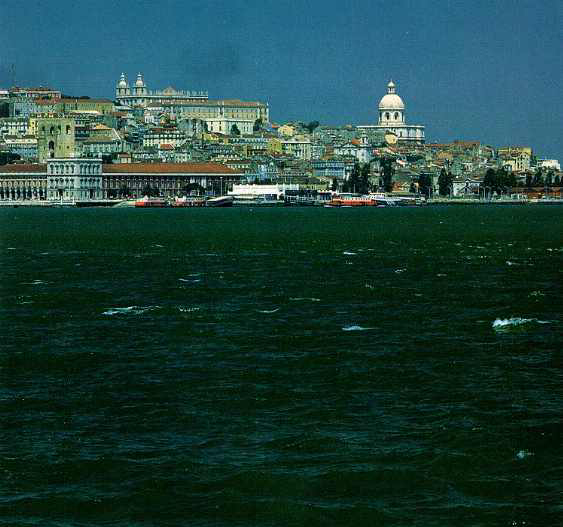

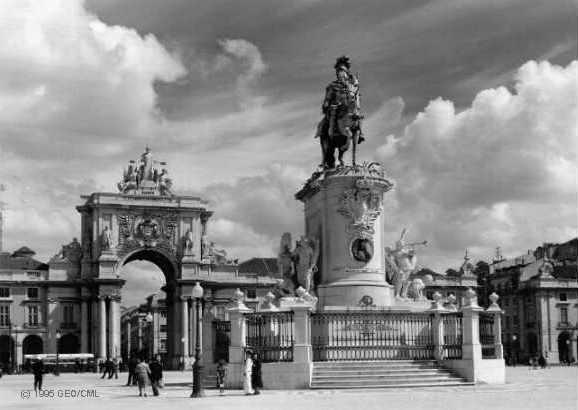
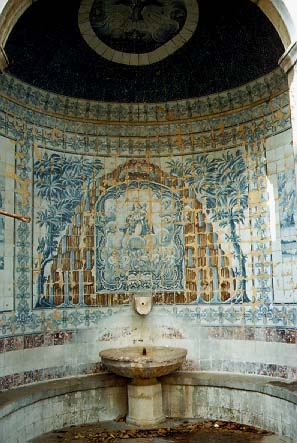
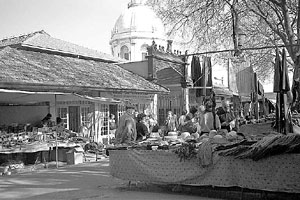
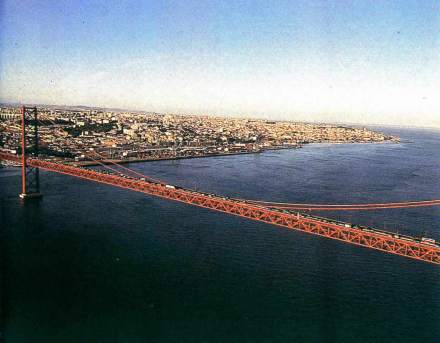

The City
The Rossío - itself more or less encircled by cafés
- is very much a focus for the city, yet its single concession to grandeur
is the Teatro Nacional, built along the north side in the 1840s.
At the waterfront end of the Baixa, the Praça do Comércio
was intended as the climax to Pombal's design, but these days it's a tawdry
spot - more car park than square - though the town planners are working
to bring the square back into the hub of city life by pedestrianizing the
area.
f the Praça do Comércio is the church of Conceição
Velha, severely damaged by the earthquake but retaining its flamboyant
Manueline doorway, an early example of this style which hints at the brilliance
that emerged at Belém. The Cathedral - or Sé
stands very stolidly above. Founded in 1150 to commemorate the city's reconquest
from the Moors, it in fact occupies the site of the principal mosque of
Moorish Lishbuna. Like so many of the country's cathedrals, it is
Romanesque and extraordinarily restrained in both size and decoration.
For admission to the thirteenth-century cloisters you must buy a
ticket, as you must for the Baroque sacristy with its small museum
of treasures - including the relics of Saint Vincent, allegedly brought
to Lisbon in 1173 in a boat piloted by ravens.
From the Sé, Rua Augusto Rosa winds upward towards the
Castelo, past sparse ruins of a Roman theatre and the Miradouro de Santa
Luzia, where the conquest of Lisbon and the siege of the Castelo de
São Jorge are depicted in azulejos on the walls. At the entrance
to the Castelo stands a triumphant statue of Afonso Henriques, conqueror
of the Moors. Of the Moorish palace that once stood here only a much-restored
shell remains - but the castle as a whole is an enjoyable place to spend
a couple of hours, wandering amid the ramparts and towers to look down
upon the city. Crammed within the castle's outer walls is the tiny medieval
quarter of Santa Cruz, once very much a village in itself though
now littered with gift shops and restaurants.
alls of the Castelo to the banks of the Tagus, is the oldest part of
Lisbon. In Arab times this was the grandest part of the city, but with
subsequent earthquakes the new Christian nobility moved out, leaving it
to the fishing community still here today. It is undergoing some commercialization,
thanks to its cobbled lanes and "character", but although the antique shops
and restaurants may be moving in, the quarter retains a largely traditional
life of its own. The Feira da Ladra, Lisbon's rambling and ragged
flea market, fills the Campo de Santa Clara, at the edge of Alfama,
on Tuesday mornings and all day Saturday. While at the flea market, take
a look inside Santa Engrácia, the loftiest and most tortuously
built church in the city - begun in 1682, its vast dome was finally completed
in 1966. Through the tiled cloisters of nearby São Vicente de
Fora you can visit the old monastic refectory, since 1855 the pantheon
of the Bragança dynasty. Here, in more or less complete (though
unexciting) sequence, are the bodies of all Portuguese kings from João
IV, who restored the monarchy, to Manuel II, who lost it and died in exile
in England in 1932.
Mésnier's extraordinary Elevador Santa Justa, just off
the top end of Rua do Ouro on Rua de Santa Justa, is the most obvious approach
to Bairro Alto. Alternatively, there are the two funicular-like
trams - the Elevador da Glória from the Praça dos
Restauradores (just up from the tourist office) or the Elevador da Bica
from Rua de São Paulo/Rua da Moeda. The ruined Gothic arches of
the Convento do Carmo hang almost directly above the exit of Mésnier's
elevador. Once the largest church in the city, this was half-destroyed
by the earthquake but is perhaps even more beautiful as a result; it now
houses a small archeological museum. The church of São Roque,
over towards the Chiado in the Largo Trindade Coelho , looks from the outside
like the plainest in the city, its bleak Renaissance facade having been
further simplified by the earthquake. But hang around in the gloom and
the sacristan will come and escort you around, turning on lights to an
incredible succession of side chapels, each lavishly crafted with azulejos,
multicoloured marble, or Baroque painted ceilings. The climax is the Capela
de São João Baptista, last on the left. It was ordered from
Rome in 1742 by Dom João V to honour his patron saint and was designed
using the most costly materials available, including ivory, agate, porphyry
and lapis lazuli.

